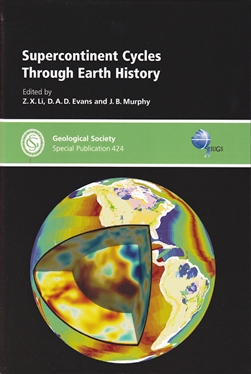Supercontinent Cycles through Earth History
 Geoscientist readers who viewed the recently repeated BBC4 broadcast of Iain Stewart’s series ‘The Rise of the Continents’, were provided with an eminently watchable, informative and accessible introduction to the evolutionary cycling of Earth’s continents and supercontinents. This GSL Special Publication presents the geoscientific research underpinning the subject, reporting current developments in numerical and theoretical modelling, source data acquisition used in continental reconstructions and the spatial / temporal correlations between global geodynamic events, plate kinematics and palaeoenvironmental histories. Investigating how supercontinent cycles interact with the deep mantle is fundamental to understanding how the Earth’s tectonic ‘engine’ operates.
Geoscientist readers who viewed the recently repeated BBC4 broadcast of Iain Stewart’s series ‘The Rise of the Continents’, were provided with an eminently watchable, informative and accessible introduction to the evolutionary cycling of Earth’s continents and supercontinents. This GSL Special Publication presents the geoscientific research underpinning the subject, reporting current developments in numerical and theoretical modelling, source data acquisition used in continental reconstructions and the spatial / temporal correlations between global geodynamic events, plate kinematics and palaeoenvironmental histories. Investigating how supercontinent cycles interact with the deep mantle is fundamental to understanding how the Earth’s tectonic ‘engine’ operates.
The supercontinent-cycle model assigns episodic global-scale tectonic events to an essentially self-regulating system of mantle convection, controlled by the relative buoyancy of continental lithosphere that ‘opposes’ subduction during the closure of existing ocean basins, with the consequent reorganisation of mantle convection cells leading to the opening of new ocean basins. Cycle timescales are each typically of 500 – 700 ma duration. The proposed spatial patterns (or kinematic styles) of supercontinental tectonic cyclicity range from the hemispheric (‘introversion’) to antipodal (‘extroversion’), with other cycles incorporating characteristics transitional (‘orthoversion’) between these end-member conditions.
Written in the established GSL Special Publications series format, the volume is introduced with a contextual overview paper and contains 11 research contributions on the four identified (or hypothesised) palaeogeographic – kinematic supercontinent cycles. Presented chronologically within the framework of the three-fold geodynamic models, the cycles are - cycle 1: Kenorland to Nuna, cycle 2: Nuna to Rodinia, cycle 3: Rodinia to Pannotia / Gondwana and cycle 4: Gondwana / Pangea to Amasia. (Kenorland is the title given to the postulated supercontinent at the Archean – Palaeoproterozoic transition). Current and continuing research from the related disciplines of mantle convection cell and plume dynamics, palaeomagnetism, geochronology, geochemistry, metallogenesis and tectonostratigraphy have all combined to provide valuable new insights.
All contributions are well written and edited, concisely laid-out with clear and appropriate figures, photographs and data-tables. Many are presented in colour and enhance the understanding of the textual details. The volume is a comprehensive contribution to this interdisciplinary field, and the editors are to be congratulated. A recommended read and authoritative reference work.
Reviewed by Mark Griffin
SUPERCONTINENT CYCLES THROUGH EARTH HISTORY Edited by LI, Z X, EVANS D A D AND MURPHY J B Geological Society of London Special Publication #424. 2016. ISBN 978-1-86239-733-0. (hbk). 297pp. ISSN 0305-8719. List Price: £110.00, W: www.geolsoc.org.uk/sp424